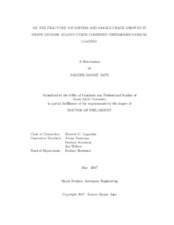| dc.description.abstract | Advanced multifunctional materials such as shape memory alloys (SMAs) offer unprecedented improvement over conventional materials when utilized as high power output solid-state actuators in a plethora of engineering applications, viz. aerospace, automotive, oil and gas exploration, etc., replacing complex multi-component assemblies with compact single-piece adaptive components. These potential applications stem from the material's ability to produce large recoverable actuation strains when subjected to combined thermomechanical loads, via a diffusionless solid-to-solid phase transition between high-temperature cubic austenite and low-temperature monoclinic martensite crystalline phases. To ensure reliable design, functioning and durability of SMA-based actuators, it is imperative to develop a thorough scientific knowledge base and understanding about their fracture properties i.e. crack-initiation and growth during thermal actuation, vis-a-vis the phase transformation metrics (i.e. transformation strains, hysteresis, and temperatures, critical stresses for phase transformation, etc.) and microstructural features (grain size, precipitates, and texture). Systematic experimental and analytical investigation of SMA fracture response based on known theories and methodologies is posed with significant challenges due to the inherent complexity in SMA thermomechanical constitutive response arising out of the shape memory and pseudoelastic effects, martensite detwinning and variant reorientation, thermomechanical coupling, and transformation induced plasticity (TRIP). In this study, a numerical analysis is presented that addresses the fundamental need to study fracture in SMAs in the presence of aforementioned complexities. Finite element modeling with an energetics based fracture toughness criterion and SMA thermomechanical behavior with nonlinearities from thermomechanical coupling and TRIP was conducted. A specific analysis of a prototype boundary value fracture problem yielded results similar to those obtained experimentally, viz. stable crack growth with transformation toughening, dependence of failure cycle on bias load and catastrophic failure during cooling, and are explained using classical fracture mechanics theories. Influence of TRIP as a monotonically accumulating irrecoverable plastic strain on the crack-tip mechanical fields in case of stationary and advancing cracks is also investigated using the same computational tools. Thermomechanical coupling in shape memory alloys, which is an important factor when utilized as solid-state actuators manifests itself through the generation and absorption of latent of transformation and leads to non-uniform temperature distribution. The effect of this coupling vis-a-vis the mechanics of static and advancing cracks is also analyzed using the energetics based approach. | en |


